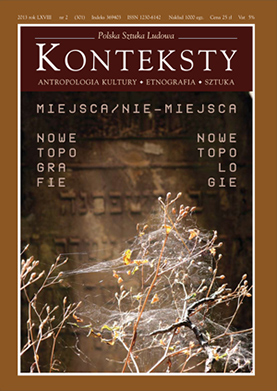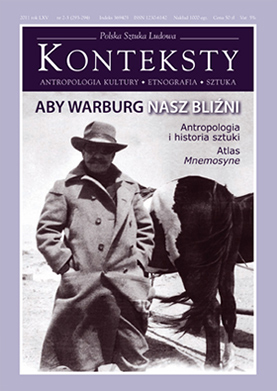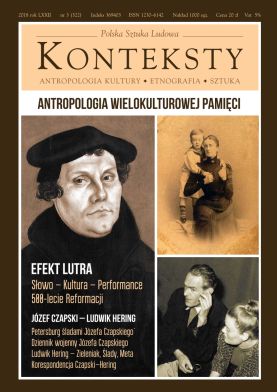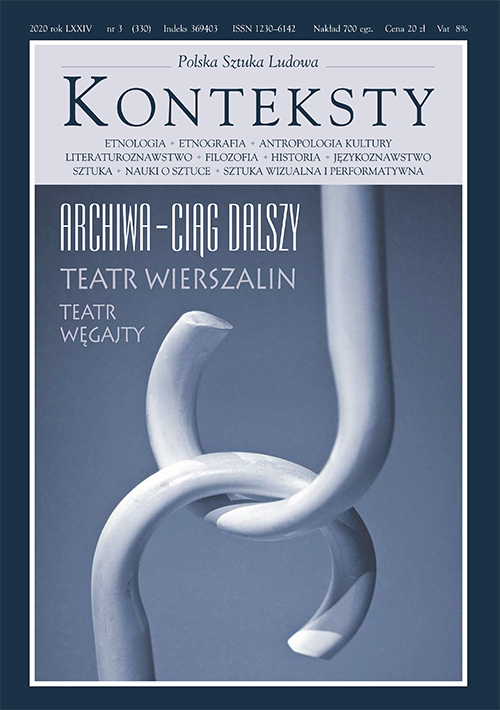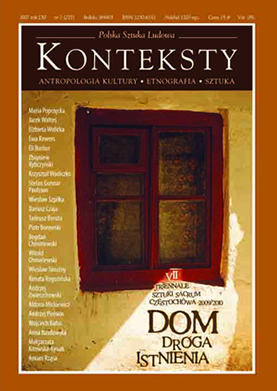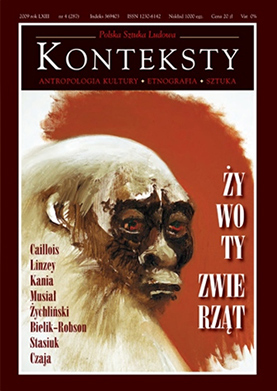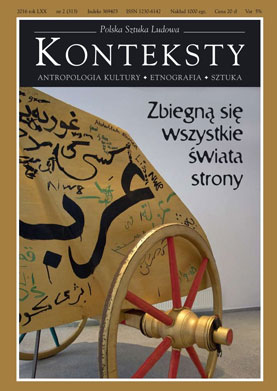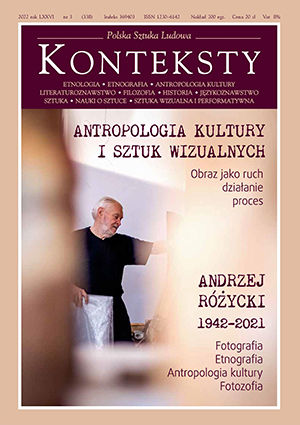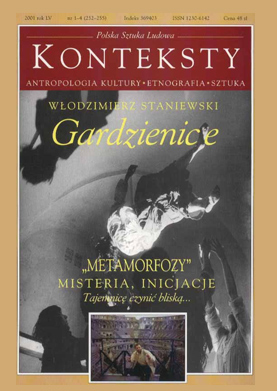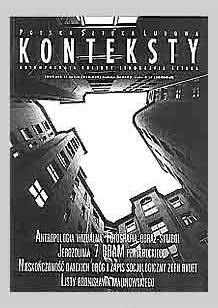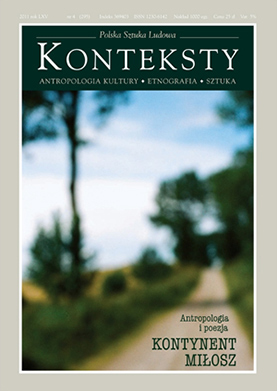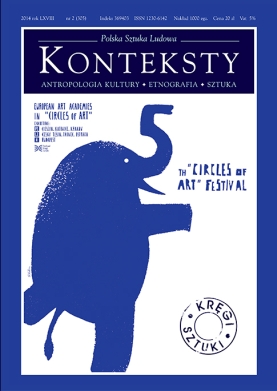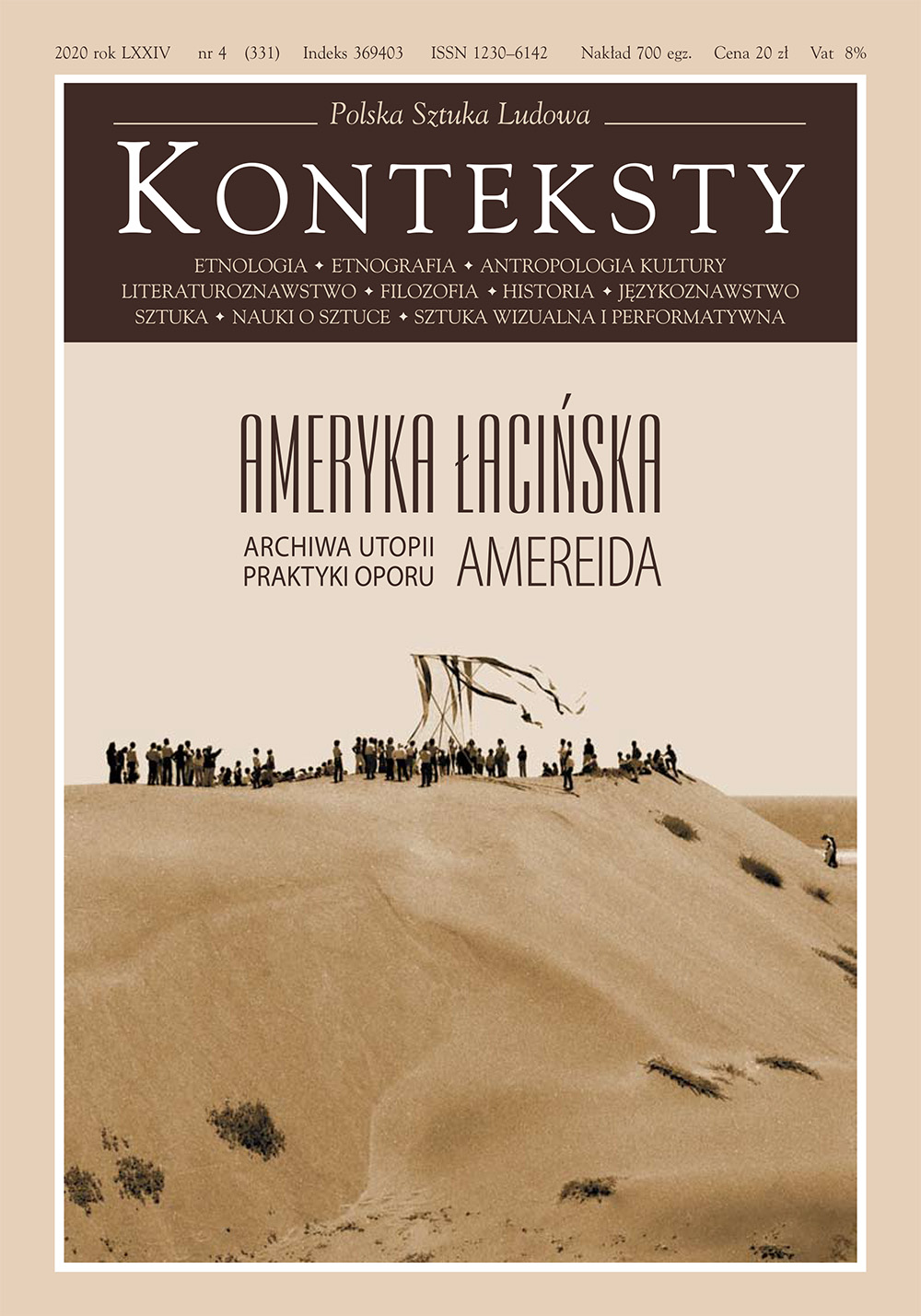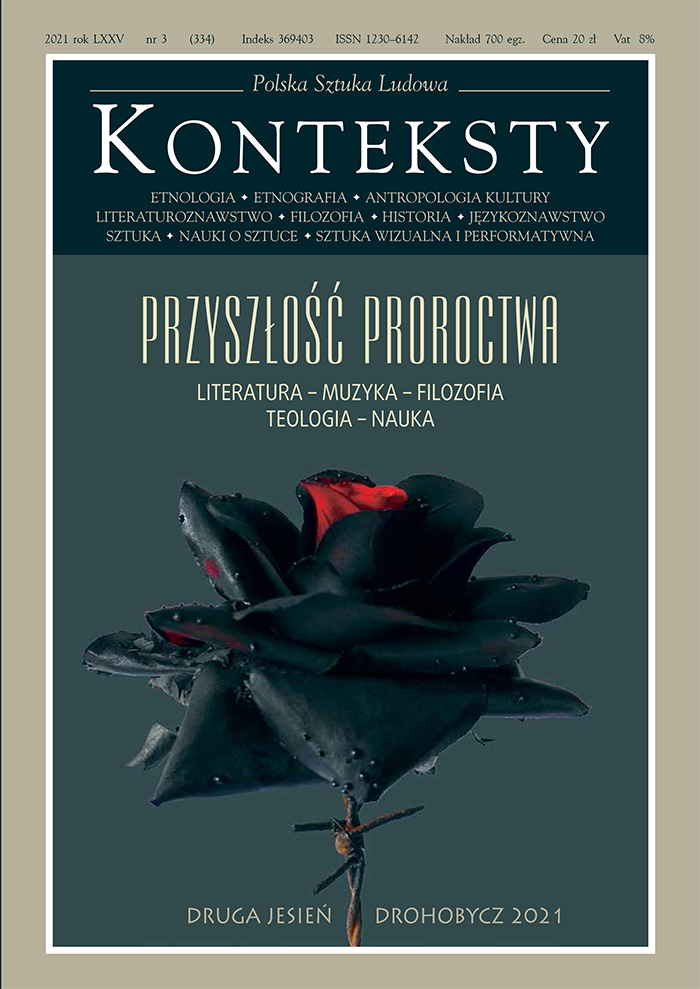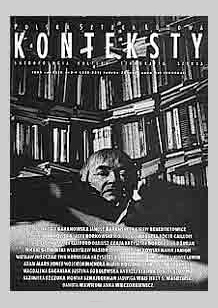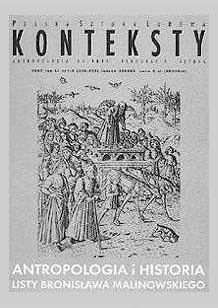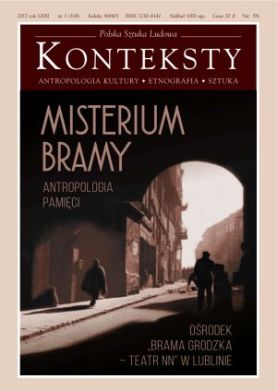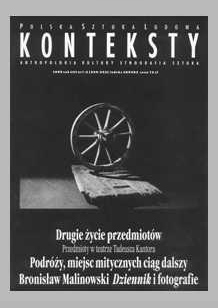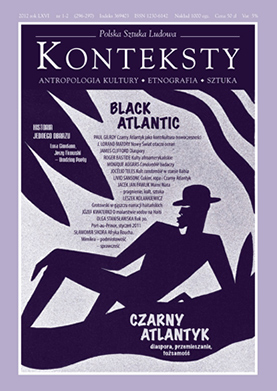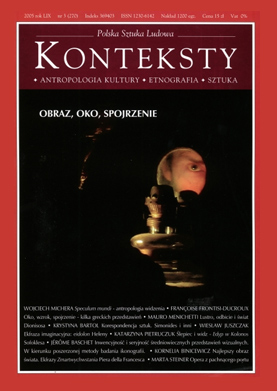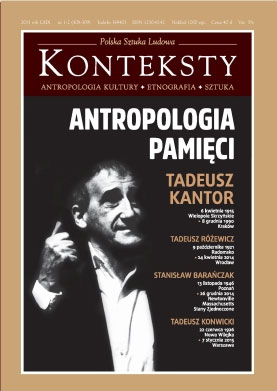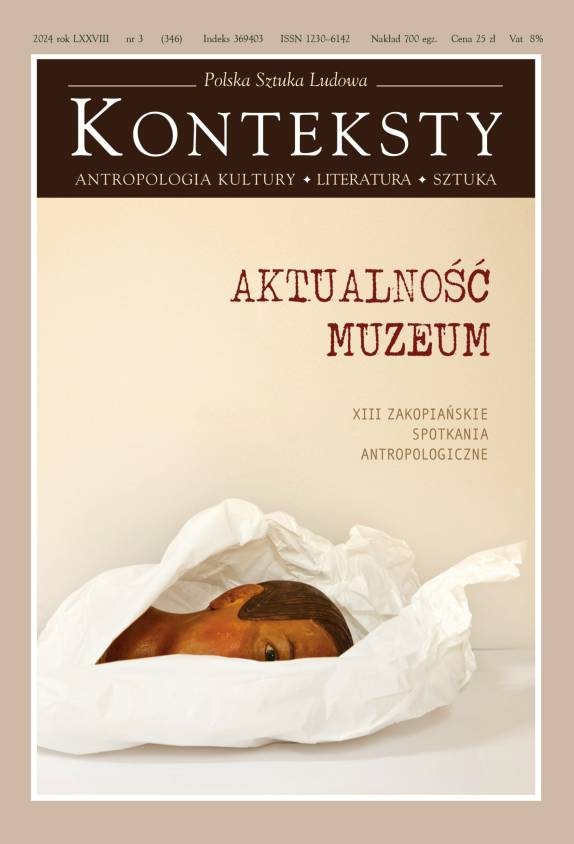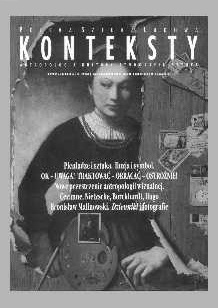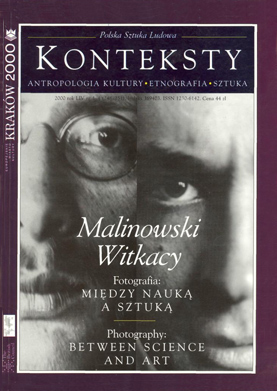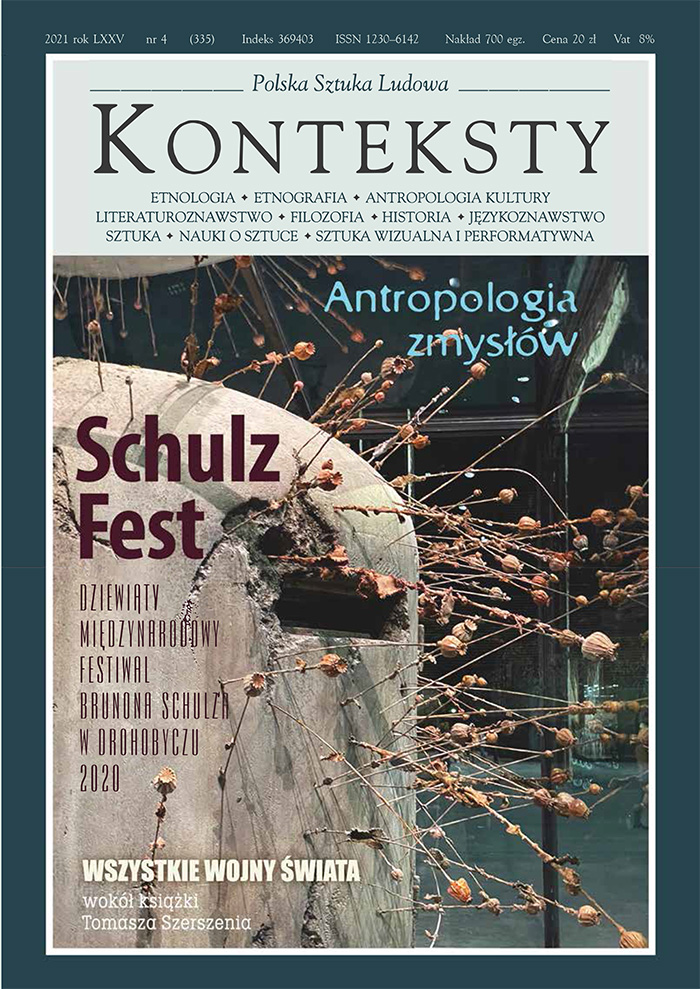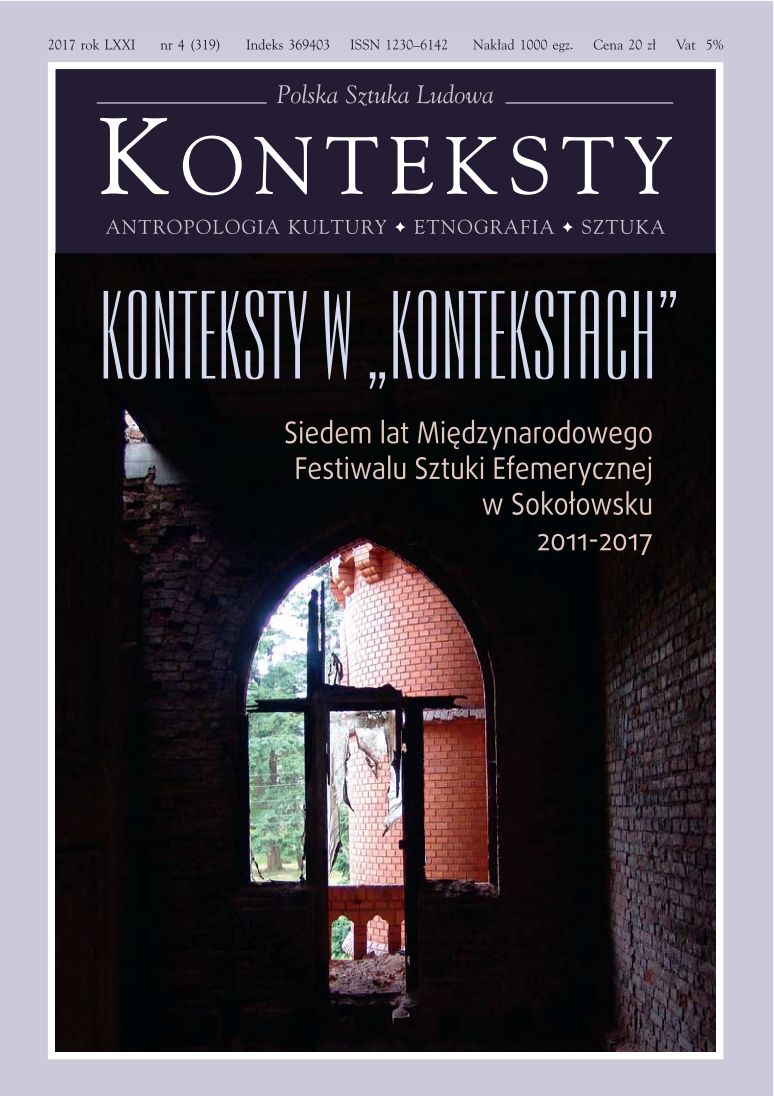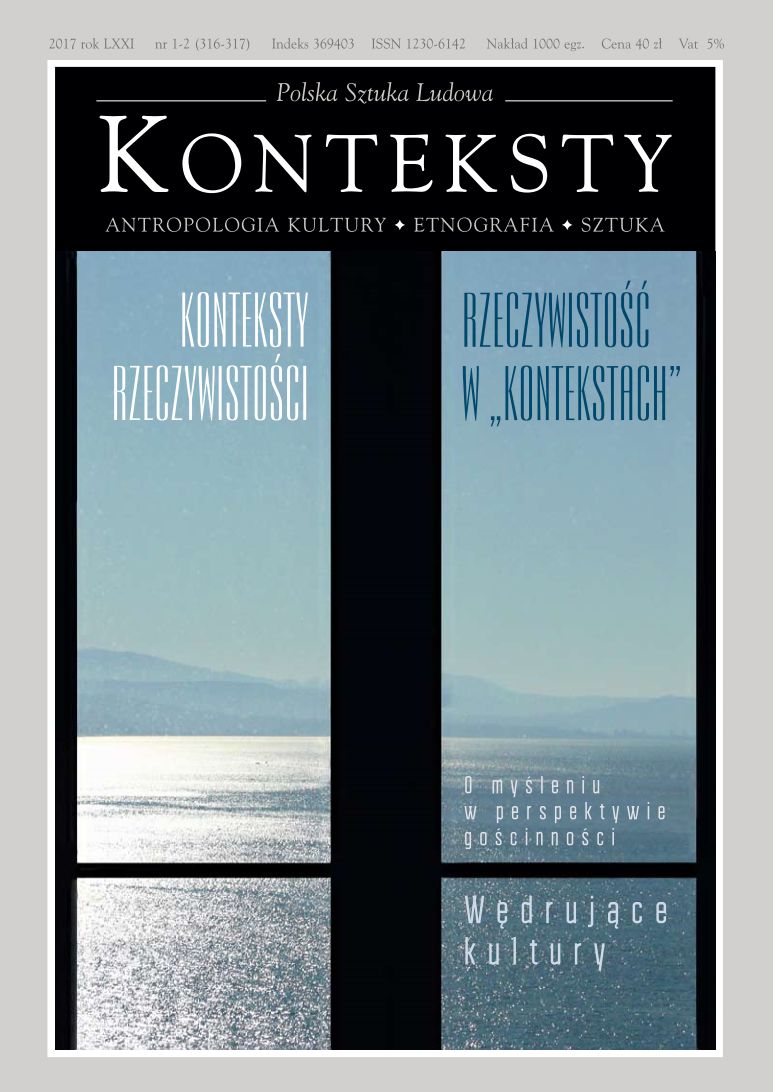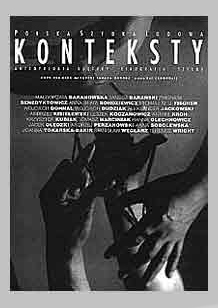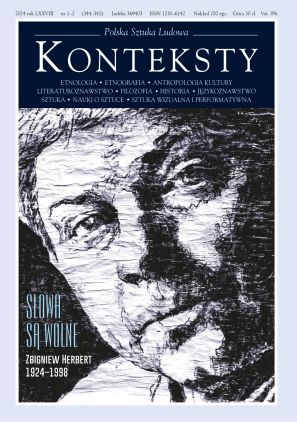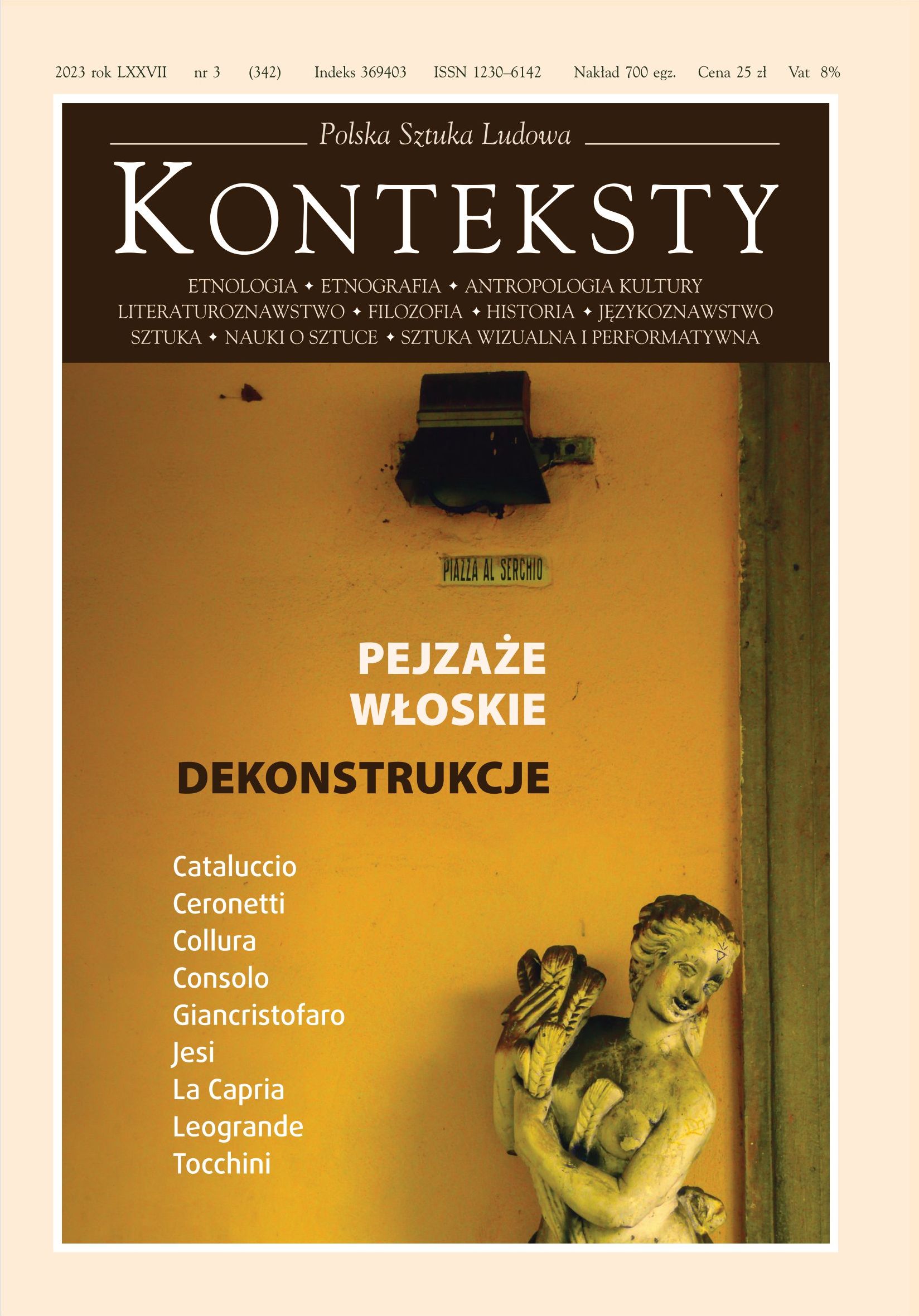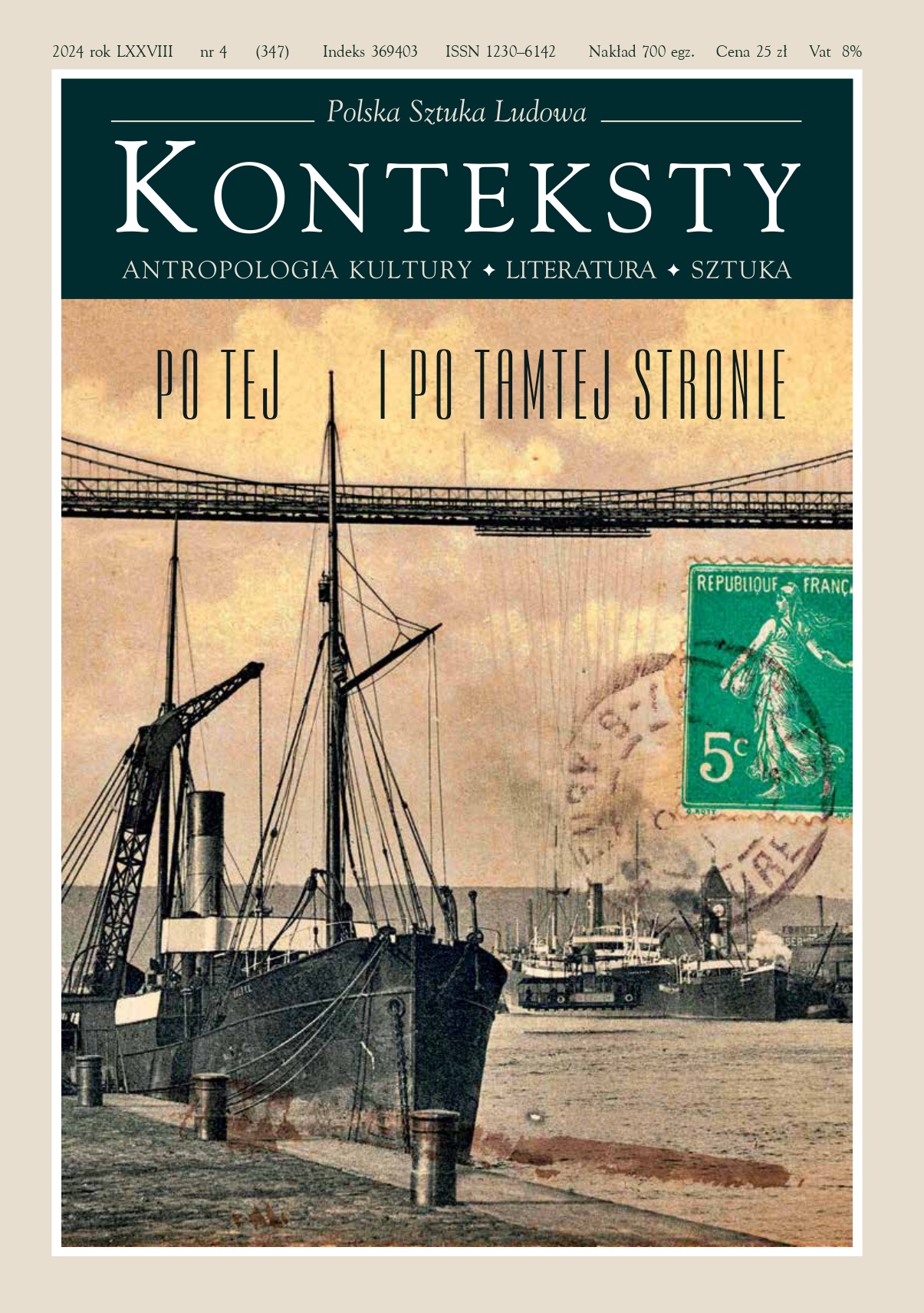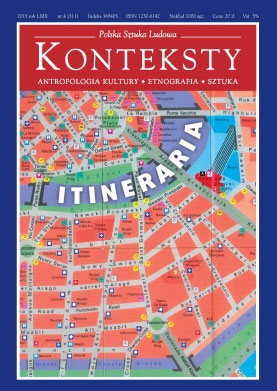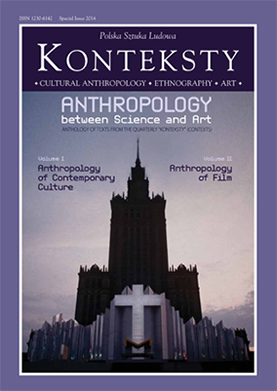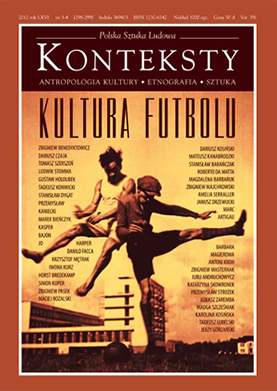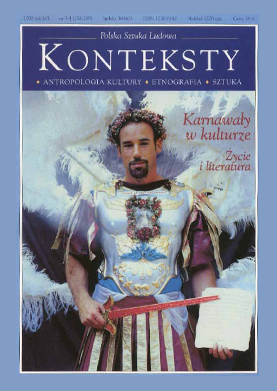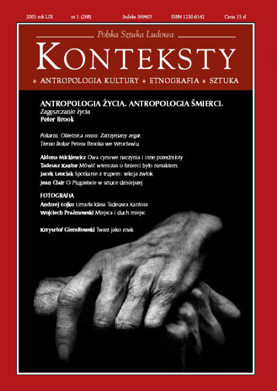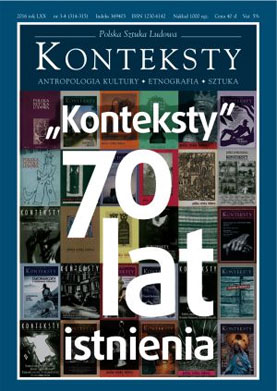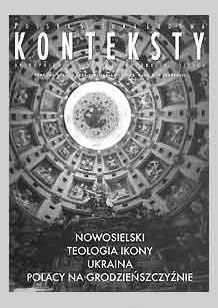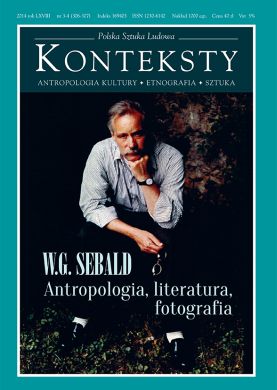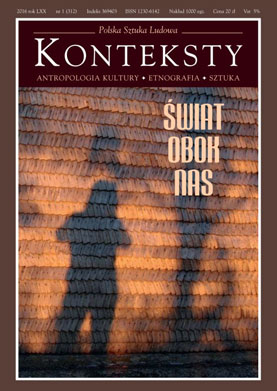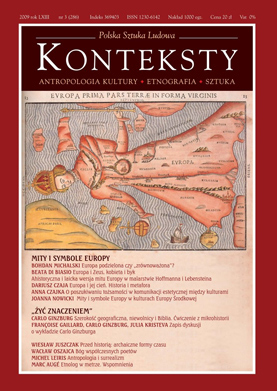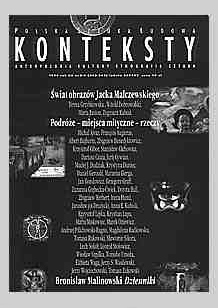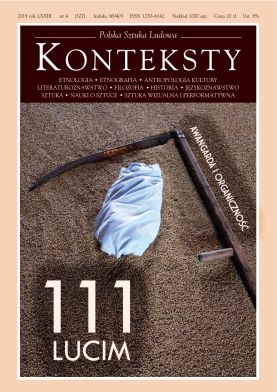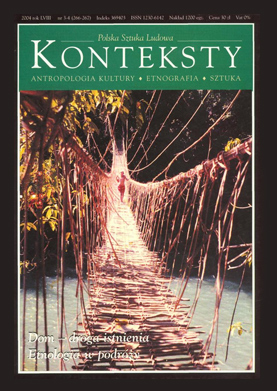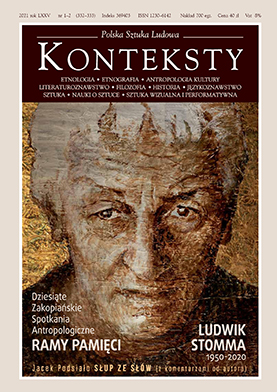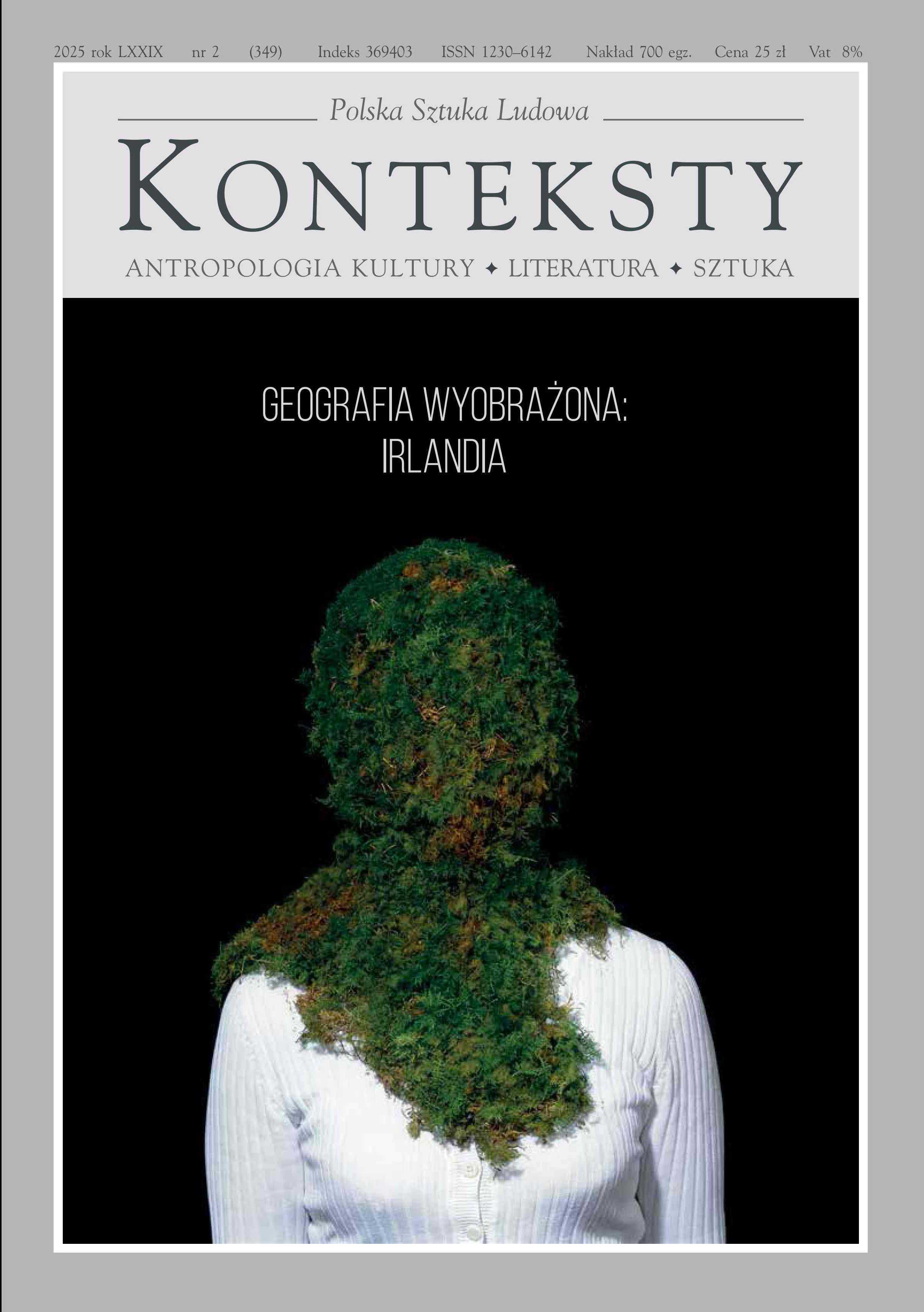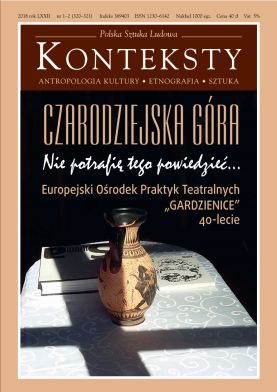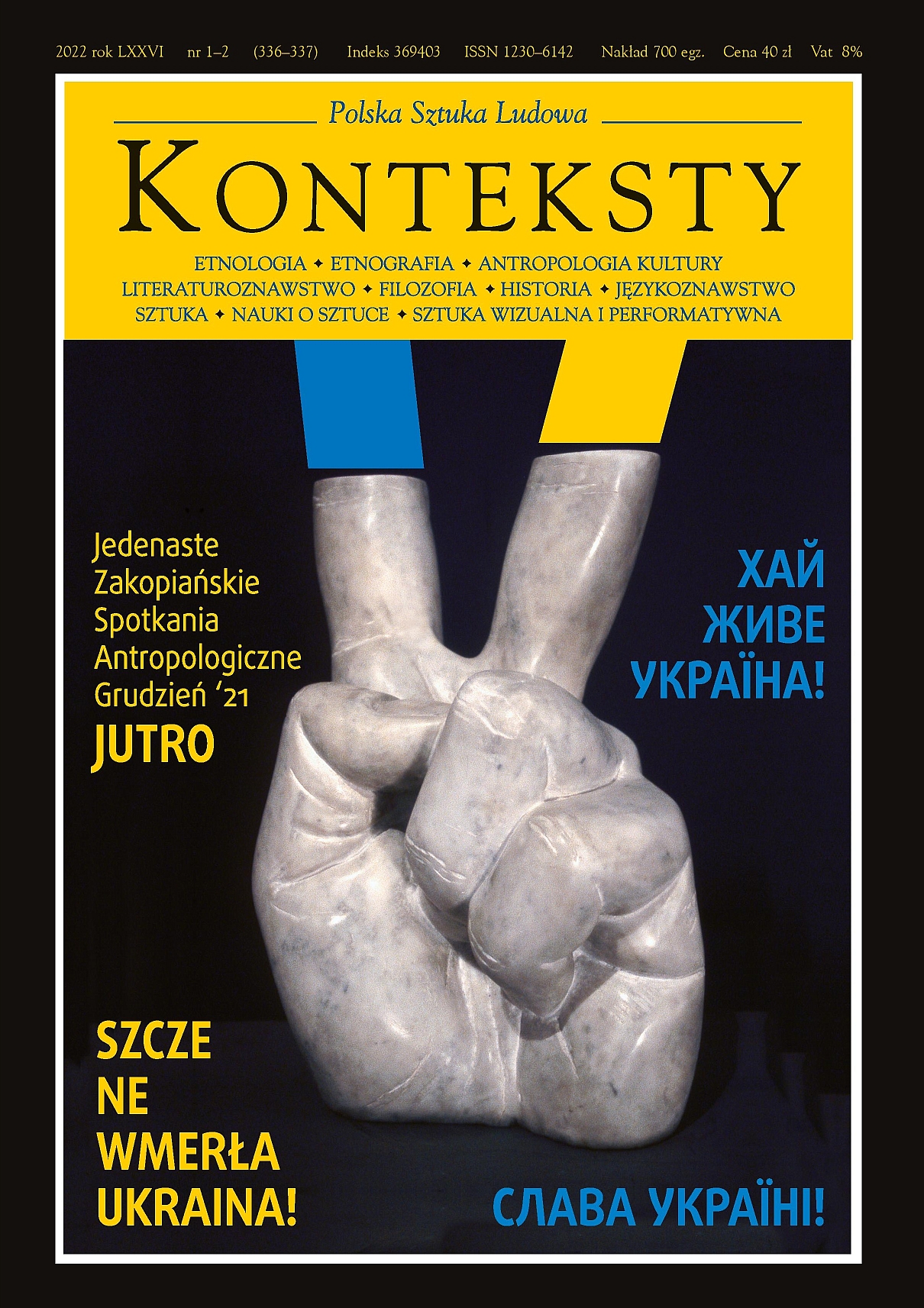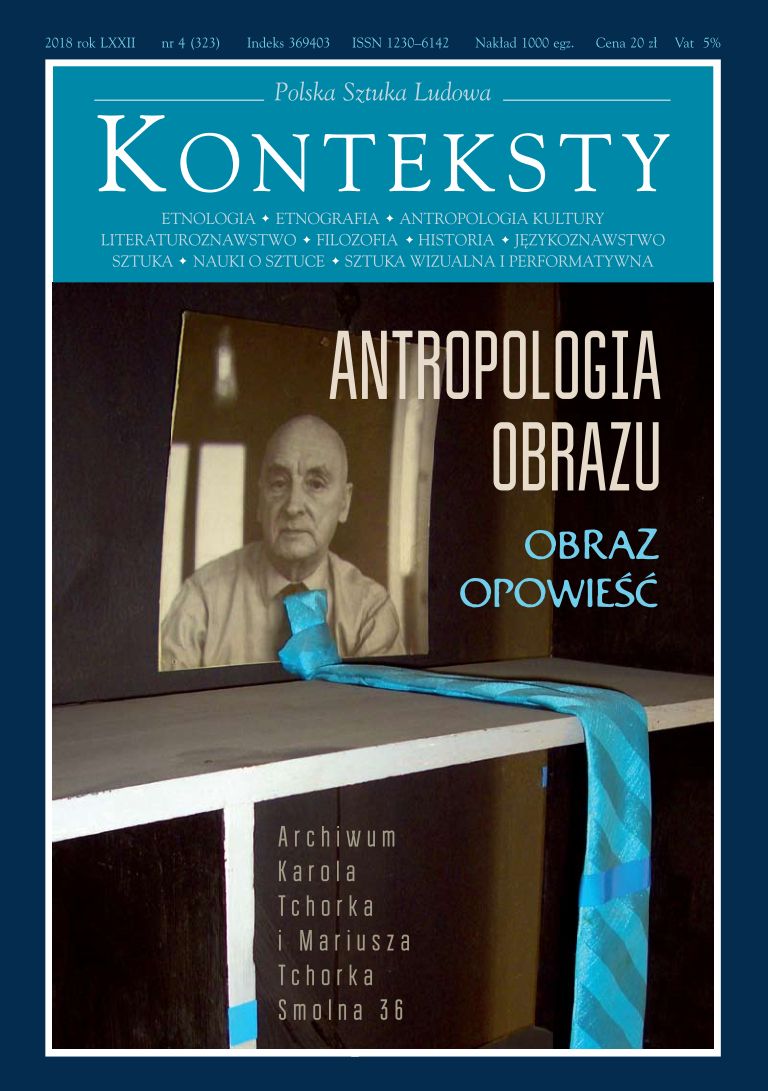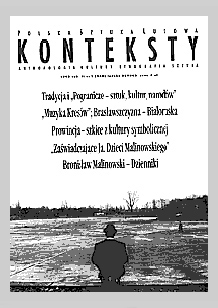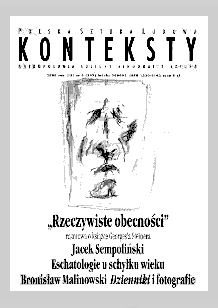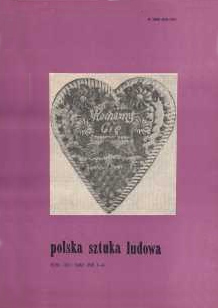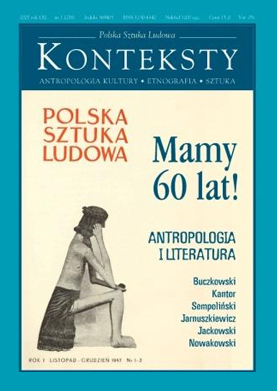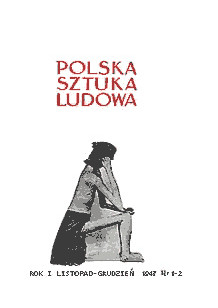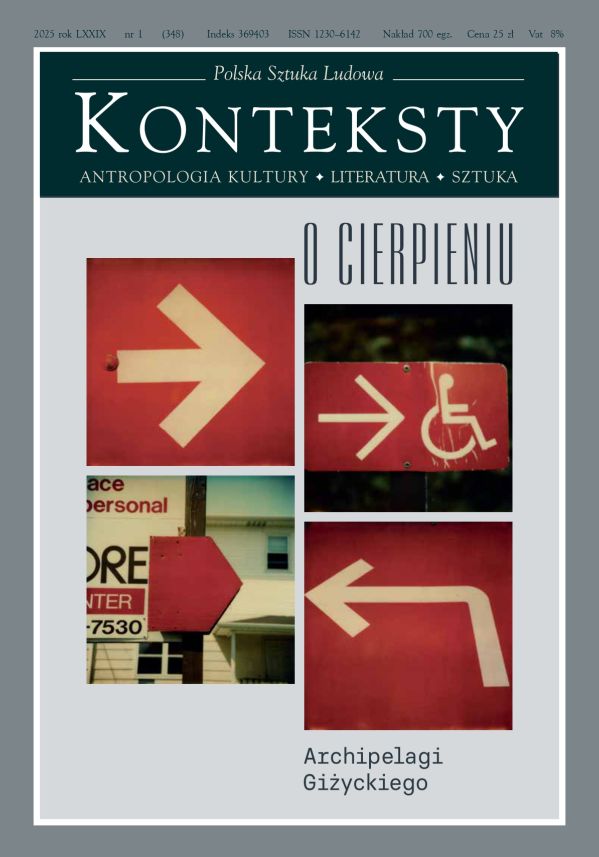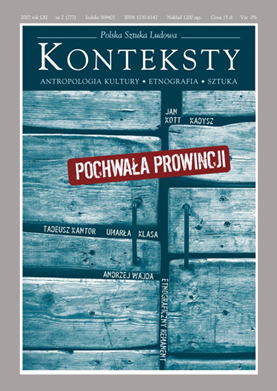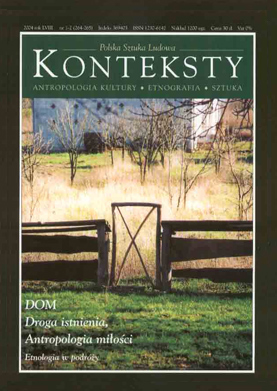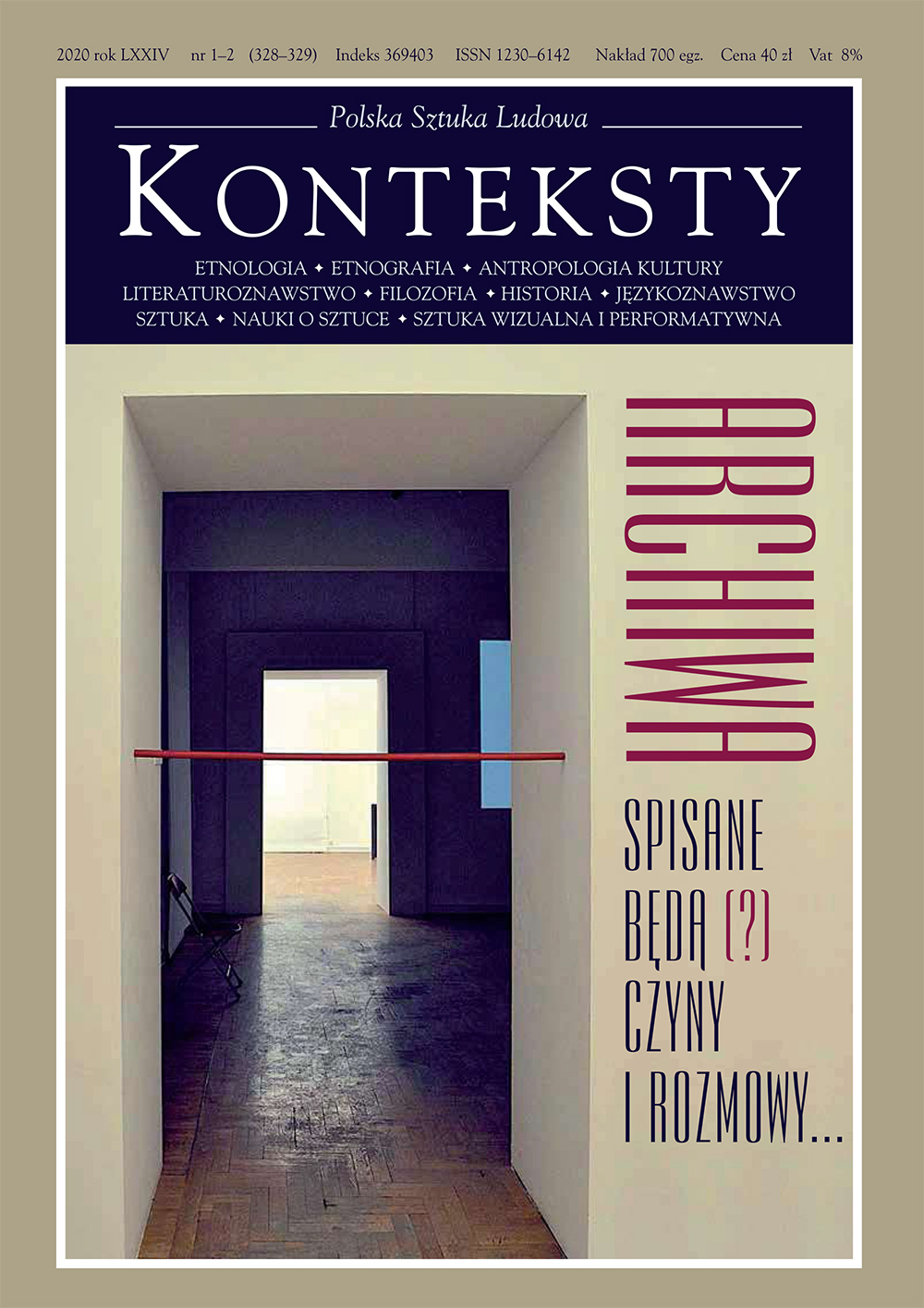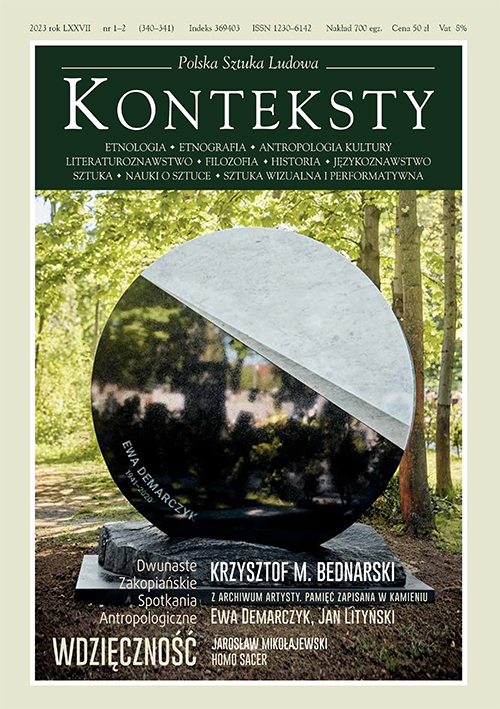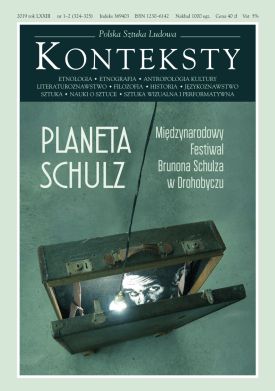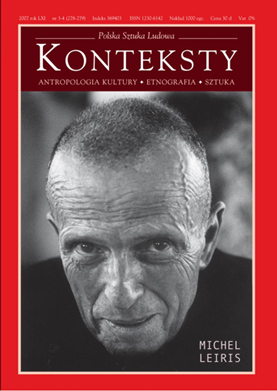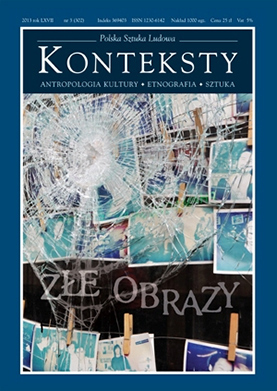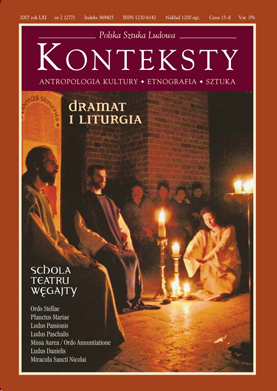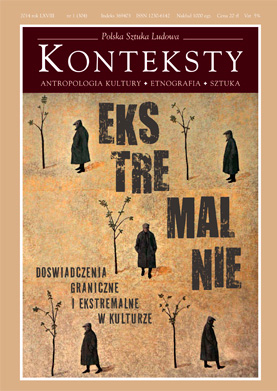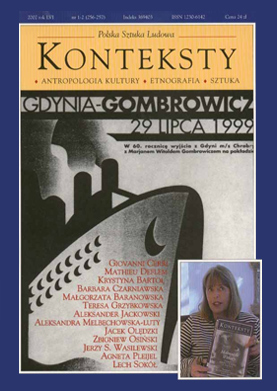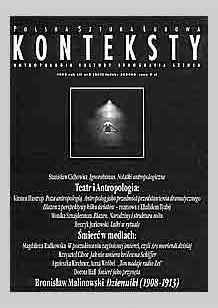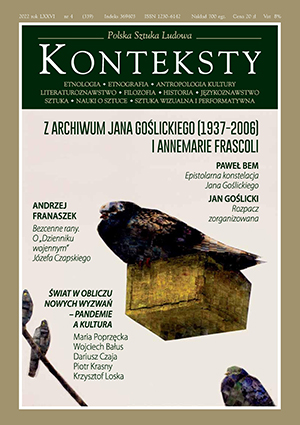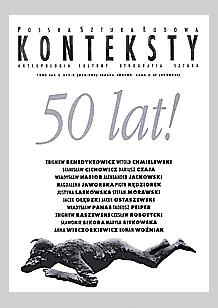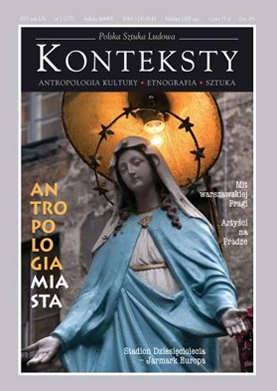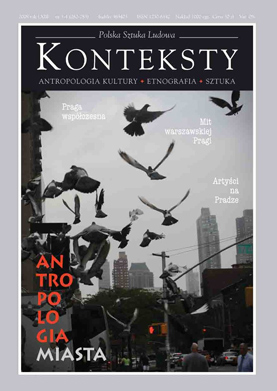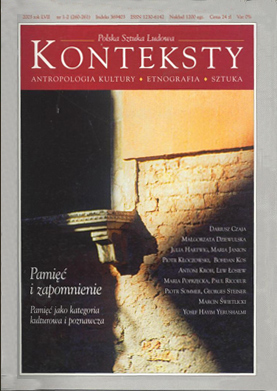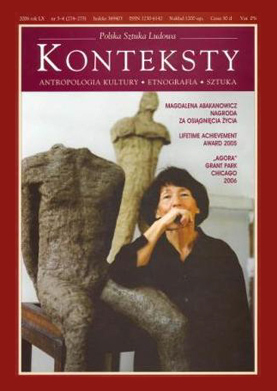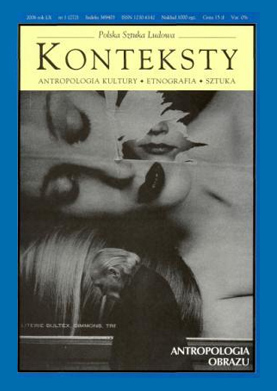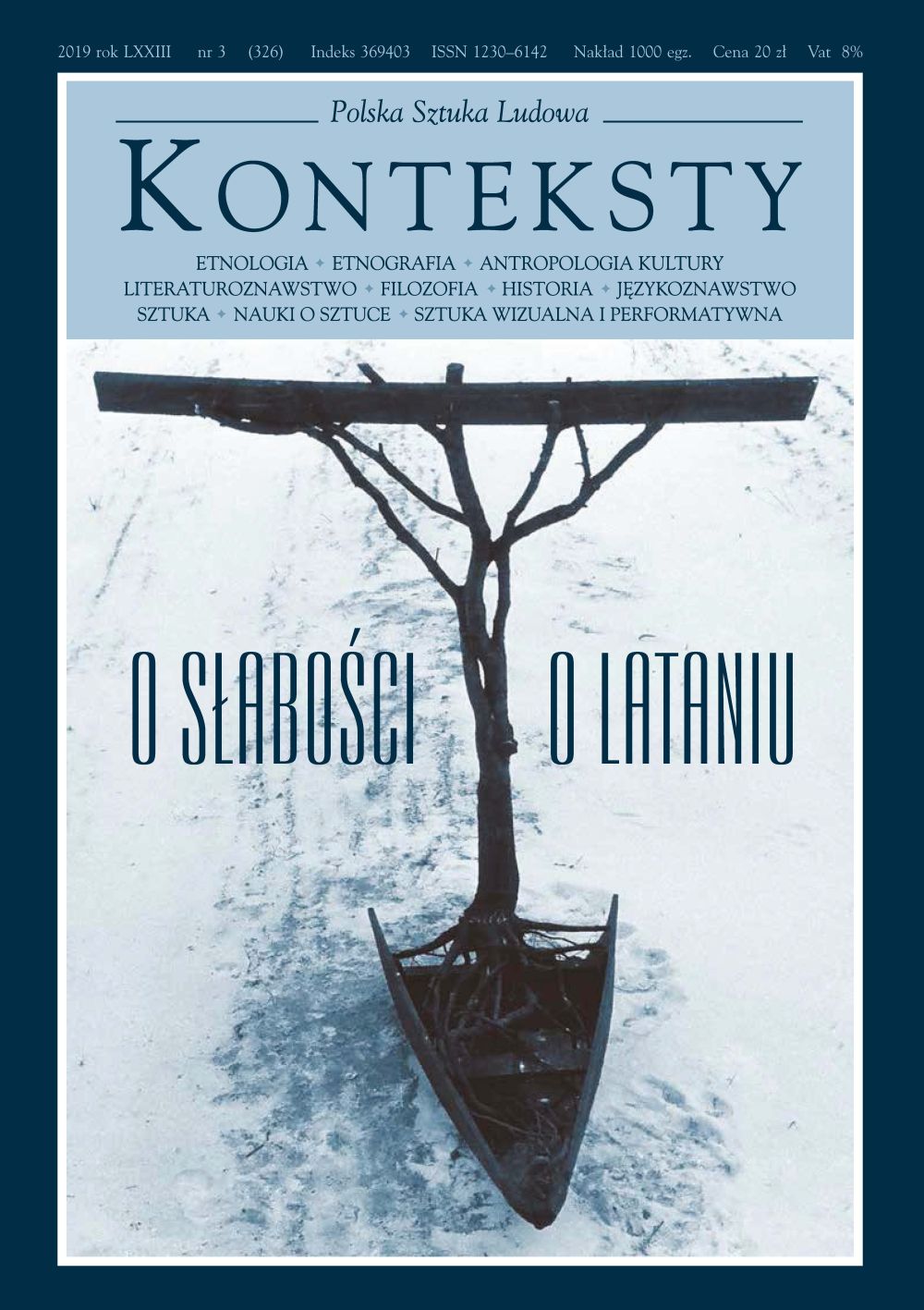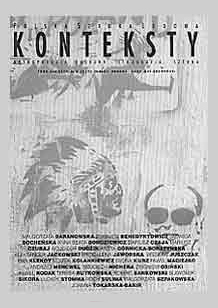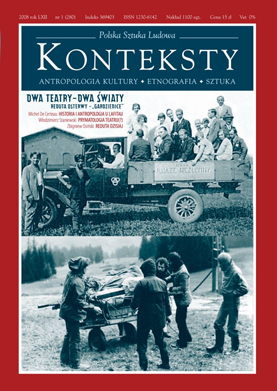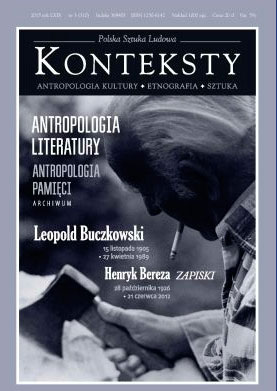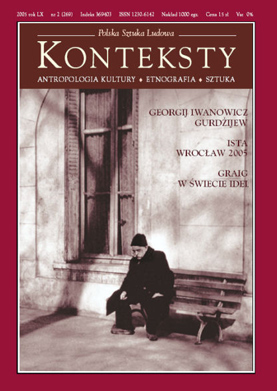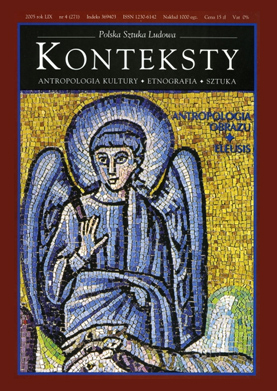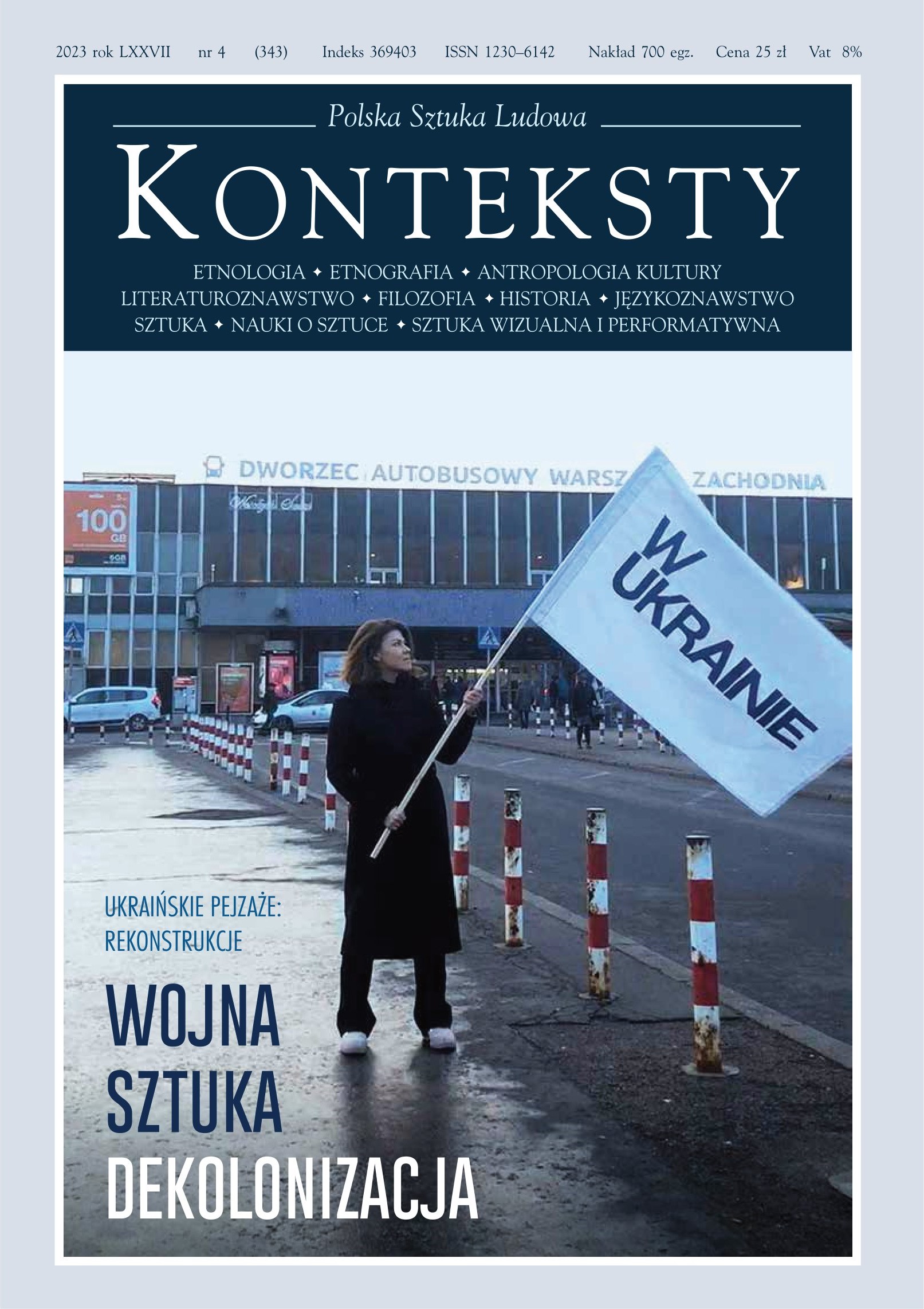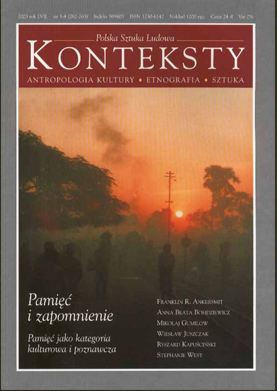Issue 2006/2 (273) -
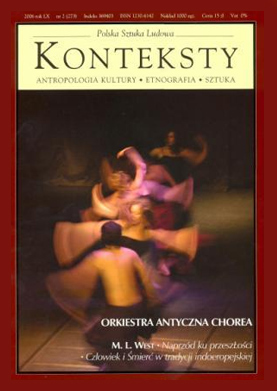
| Zbigniew Benedyktowicz | Continuity | 3 |
| Jerzy S. Wasilewski | The Travelling Ethnologist. Triste Arctique in a shamanic costume, under a festival masque  | 5 |
The everyday life of the Eveny (so Vitebsky, 2005), a group of reindeer herders of Yakutia ( Siberia ) is split or dissociated in several ways. The male herders, migrating continuously in the taiga, are separated from their settled-down womenfolk, which results in a basic discontinuity in the transmission of culture. With the post-soviet economic collapse animal husbandry lost its meaning. The purpose of the reindeer herders festival in Topolino is to re-establish hope and a sense of meaning. Organized and choreographed by local authorities, which accounts for its bureaucratic folklore and political nostalgia, it gives nevertheless the herders a rare chance “to show off themselves and to look at the others”. A crucial personage of the old culture, the shaman, moved away to the capital city, where the customers are. And so did another unusual member of the Eveny group, Anatoliy Alekseev, an outstanding culture broker who introduced Savey, a shaman from the taiga, to the modern city public. With his truly tricksterian qualities, he provides an impressive mix of mythological and scientific explanations for Savey’s actions, thus enriching their spiritual dimension and contributing to their attractiveness (see his unusual photos from a shamanistic séance, showing allegedly supernatural powers at work). | ||
| *** | ||
| Anna Bogdanowicz | The Bulgarian “Banica” with Cheese and Spinach.” Turkish” Coffee and Vine Leaves, or on the Need for Experiencing the Different in the Theatrical Quest  | 15 |
The text that opens the chapter is an impression after the group’s journey to Bulgaria between May and June 2005. It is a subjective account of a few meetings with Bulgarian folk culture, witch were also a search for inspiration to theatre work with iconography and music of Ancient Greece. | ||
| Tomasz Rodowicz | Why Antiquity, or the Condition of Europe The Chorea Theatrical Society 2004-2006  | 21 |
The text by Tomasz Rodowicz – one of the founders of the Association concerns the origins of the Association and situates the phenomenon in the wider historical context and in the context of the personal experience of the author. The text is an attempt to sum up the hitherto achievements of the Association and sketch the plans for upcoming projects. | ||
| Tomasz Rodowicz | 28 | |
| Tomasz Rodowicz | 29 | |
| Martin L. West | Forward to the past translated by Marianna Cielecka | 30 |
| Martin L. West | Music of Ancient Greece . Its Transmission Then and Now translated by Sara Rodowicz, checked by Włodzimierz Lengauer | 34 |
| Martin L. West | Ancient Greek Music: its transmission then and now translated by Maciej Kaziński, Anna Bogdanowicz  | 43 |
The author of the three followig texts – Martin L. West – the prominent classicist and musicologist, author of Music of Ancient Greece (Polish translation by A. Maciejewska and M. Kaziński, Homini Publishing House, 2003) visited Poland in October 2004 at the invitation of the Theatre Association Chorea and Homini Publishing House. During the visit he gave two of the three lectures published here (Music of Ancient Greece . Its Transmission Then and Now Institute of Art, Polish Institute of Science, Warsaw and Man, Destiny and Death in Indoeuropean Tradition, Jagiellonian University , Cracow ). | ||
| Krzysztof Bielawskl | The Paeans of Delphi – Historical Context  | 52 |
Article by Krzysztof Bielawski is a fragment of the book (Poetic Texts of Greek music fragments) that is being prepared for publishing. He places the paeans that were performed at the occasion of Delphic festivals, in the religious, social and political context. He also writes about the performers – the technitai – artists of Dionysios that were associated in the guilds. | ||
| Dariusz Kosiński | Clouds  | 60 |
Essay Clouds by Dariusz Kosiński is reflection after performance After the Birds (Theatre Association Chorea in cooperation with Earthfall Dance). The author situates the performance in the context of the contemporary theatre and music phenomena in Poland , inspired by the culture of Antiquity. He develops his iterpretation in relation to the text of Aritophanes The Birds, which was the pretext for the performance. | ||
| Dorota Porowska | Theseus and the Labyrinth Dances  | 65 |
Dorota Porowska writes about the beginning of the work with the group of the Dances of the Labyrinth, interweaving the personal reflections with the technical explanations of the methods of work and giving some resources for the research that accompanied “reading” vase painting through the body. She also writes about the myth that became the basis for the performance Theseus in the Labyrinth and she explains interpretative traits that constitute the “reality” of the performance. | ||
| Agata Zyglewska-Diduszko | Theseus in the Labyrinth  | 69 |
Then Agata Zyglewska, in her review of the performance organizes her reasoning around the three chosen motives: ‘Woman and Bull’, ‘Theseus and Labyrinth’ and ‘Community’. She also stresses the ceremonial – ritualistic traits as one of most crucial qualities of the performance. | ||
| Małgorzata Szum | The light of Antic: Hode Galatan – Earthfall / Chorea first part of the trilogy  | 72 |
The text by Małgorzata Szum is an extended review of the performance Hode Galatan, which was produced in co-operation with Welsh company Earthfall Dance. The performance was the result of putting together modern, urban form of choreography represented by the Welsh directors Jim Ennis and Jessica Cohen and interpretations of ancient Greek music performed by Ancient Orchestra run by the Polish director of the piece – Tomasz Rodowicz. The author notices in the piece the question about the form of art related to an artist’s desire of experiencing the sacred. At the same time there is a search for authenticity and a new language of expression reaching to the Greek roots of theatre and exploring the principle of chorea – the tri-unity of poetry, music and dance. | ||
| Małgorzata Jabłońska | The Dance – the Drama of the Body – the Order of the World  | 75 |
The subject of the work on iconography of Ancient Greece is also undertaken by Małgorzata Jabłońska. In her text she undertakes profound interpretation of the labyrinth of signs: dance, gesture, body, rhythm, ritual and those that are created in the relations and actions of the characters from the story in the performance Theseus in the Labyrith. She also records fragments of different versions of the myth and in relation to these she draws her associations and possible lines of interpretation. | ||
| Elżbieta Rojek | A Few Thoughts on the Training  | 81 |
The author analyses the emergent form of training that has been the result of many years of her work on Ancient Greek dance “reading” the movement from the paintings on ancient vases, relieves and other iconographic sources. She also talks about other inspirations: film, diverse form of dance, literature, and gives an example how a piece of text was made into a piece of movement. She places her discoveries in the wider context of dance theory and research quoting for example Polish dance anthropologist Roderyk Lange. She concludes her text with a statement that training in itself does not have a stable value it constantly develops and inspires new projects. She also mentions that in her research she plans to look for the “three-dimensional” kind of movement that would be useful in exposing the meaning and the emotional content of dance. | ||
| Maciej Rychły | A Pterodactyl in a Compote – Subjective Notes from Work on Classical Music in Chorea  | 85 |
The last text by musician and composer Maciej Rychły is a collection of often humorous reflections about the work with remaining fragments of Ancient Greek musical notation and composing music on their basis. The author writes about all the intricacies of the process, finds surprising analogies and in the end, appears to be a gifted storyteller. | ||
| * | 94 | |
| Krystyna Duniec | The Body in the Theatre. From Transcendence to Transgression  | 95 |
Krystyna Duniec in her text analyzes functions of human body in a contemporary theatre. She shows how an artistic function of actor body has been changing during a discussion of different theatrical and theoretical concepts of the XX century art. | ||
| Tomasz Szerszeń, Ewa Klekot | “Anthropology is Not Enough to Understand What Happens with Man in the Face of Beauty...”. A Record of a Conversation about D. Freedberg’s “The Power of Images: Studies in the History and Theory of Response”  | |
The book by David Freedberg makes an important attempt at examining the image from an anthropological vantage point. Although the author is by training an art historian he challenged his discipline by writing that the whole discourse which emerged and grew around ”art” is a mere evasion. The image always exerts a similar impact upon the recipient – Freedberg drew attention to, i. a. the Freudian motif of suppression, and underlined the religious character of art and the image. The point of departure for research into art is the question of iconoclasm. The presented text is a recorded conversation about the titular publication. | ||
| Transformations of the Category of Aesthetics in the World of the Multimedia | ||
| Alicja Kuczyńska | Shall I Close My Eyes to See?  | 106 |
It is true that we live in a world of images although their existence remains sightly ambiguous: increasingly often they are shown not only in a completed form but are merely generated. For quite some time now, their exclusive and indisposable feature has ceased to be eyewitness perception comprehended literally, since the winner in the competition with it is spontaneous imagination and its derivatives. Images exist, press all round us, and populate in great numbers all possible regions of cognition. | ||
| Katarzyna Kasia | The Author  | 108 |
Within the context of the so-called “death” of the author in contemporary art I analyze two phenomena: the non-existent author (and his works) and collective creativity rendered possible by the www web. I also refer to real examples of unreal authors, inquiring into the merits of their works and pondering on the manner in which they are perceived by contemporary philosophy. | ||
| Bogna J. Obidzińska | Painting of the Pre-Raphaelites, or the Composition Which Can Be Itself  | 114 |
In order to fulfill the function of depicting something else than itself, the painting must leave the centre of attention. It is this act of departure that art wishes to avoid. Successive attempts at rendering the representing-represented dichotomy whole proved to be ineffective – abstraction resigns from the represented, illusionism – from the representing, academic realism transforms the represented in its own fashion, and although the symbol combines both elements, the recipient, while noticing them, incessantly wavers between one and the other, unable to encompass both simultaneously. The Pre-Raphaelites insisted on the authenticity of art understood as creation based directly on Nature and according to its laws. The outcome of their work is painting which presents itself and thus makes it possible to establish contact with the reality to which it belongs and refers. In an aesthetic experience the Pre-Raphaelite oeuvre reveals both the image and the depicted world. | ||
| Alicja Sawicka | The Director’s Intentions. A Record of Assumptions  | 121 |
This text is a “record” of assumptions about the intentions motivating Krzysztof Kieślowski and the opinions which this director could have voiced in a discussion on ”The eye, the view, representation. The image in culture”. All the questions and answers come from the author of the article. The basic point of reference is a series of TV films made in 1988/1989 under the joint title of Decalogue. By citing the statements made by the director (K. Kieślowski About Myself, Cracow 1997) and proposing an interpretation of selected fragments of the Decalogue, the author outlines the artistic path followed by Kieślowski (a departure from the documentary film for the sake of the feature film) as a consequence of perceiving the danger that might be created by the power wielded by the director over the viewers of his films. In order to preserve a so-called director’s sincerity the artist begins to deprive himself of the right to use certain means while working on a concrete film. Relinquishing them one after the other, he is finally is left with nothing and compelled to resign from making movies. This takes place in a situation when the director becomes aware of the necessity of taking into consideration three intermingling perspectives: the author or authors, the protagonists, and the spectator. As a consequence – he also experiences the need to suggest to the spectator the existence of these viewpoints, a task achieved with the assistance of certain “signs”. The director is forced to leave behind assorted traces of his presence in the film: sufficiently ambiguous so that their meaning could not be identified with a certain single thought which he supposedly wished to express and at the same time sufficiently unambiguous so that they could be noticed by the spectator and recognized not as signs referring to some sort of meanings. Unwilling to appear in the role of a judge (and not wishing to allow the recipient to assume such a rank) the director must accomplish within the film an “interiorization” of a single perception, i. e. his own and the spectator’s. The basic problem which concentrates the analyses and interpretations proposed by the author of this text, is the possibility of implementing the above-outlined ideal and indicating those of its consequences which could turn against the good intentions of the artist who wishes to retain his honesty as a director. | ||
| Piotr Schollenberger | “Transcendental Narcissism” and the Philosophy of Art  | 128 |
The author discusses the question of “narcissism”, specifically understood in the phenomenological works of Merleau-Ponty, in which it denotes a perception that discovers truth within itself, the unexpressed, pre-rational truth of the world as it is, which best captures the process of painting as a work of art. Merleau-Ponty believes that although it evades the claims made by the rationalizing description, the relation between the visible and the invisible generates a linguistic, discursive meaning. In other words, it is possible to speak about art in the language of philosophy and, in addition, to speak well by doing justice to a given work of art, or not. Does the philosophical discourse apply painting as an illustration, or perhaps it unites in a common objective the solution of the mystery of visibility, or discovers within it its own “silent” reflection? Regardless of the answers we give to these questions, the problem of “narcissism” – a perception which finds the truth within itself – remains a problem not only of contemporary philosophy but also of contemporary art. | ||
| Maciej Rożalski | The “Animation” of the Image as a Method of Creating a Theatrical Work  | 136 |
The text focuses on the possibility of “animating” an already completed work of art which serves as a theme and source of inspiration in the process of creating another artwork. The author cites the example of the efforts pursued by the “Gardzienice” company while referring to ancient Greek vase painting, primarily the Francois Vase, as well as iconographic themes relating to the Greek Cabiri mysteries. | ||
| Aleksandra Hirszfeld | Greenaway á la “Greenaway” – or an Englishman’s Creative UNIVERSE in a Nutshell  | 141 |
The text is a cursory survey of the wide spectre of films by Peter Greenaway from the perspective of innumerable webs composed of events, symbols and figures. The whole Greenaway oeuvre, his collages – the reference to earlier and later works, the creation of imagery and installations or theatrical-opera spectacles which supplement his cinematic pursuits – enable the spectator to enter premises full of artifacts created not necessarily in a manner resembling the conditions and events transpiring in our world, and to cross the boundaries of a separate Universe. The article is an attempt at finding a key to this sophisticated multi-level world composed of a labyrinth of images, and at placing Greenaway’s work within a certain framework of contemporary philosophical thought, together with the prime ascertainment that the world depicted by the author of The Pillow Book ceased presenting something and became art solus ipse, part of the post modern current of multiplying Borgesian maps. The creative Universe, including every film, comprises maps of a new world, a new self-reference hyper-reality, a film model of simulation. The spectator – invited to take part in the game, to watch the film world, to celebrate the webs of connections, and to seek keys and open successive domains concealing myriad references and finely constructed mini-truths, enters a world of a schematic construction as subtly knit as Descartes’ model of reality, a Magic World of a Creative Universe built by a certain Englishman. | ||
| Aleksandra Koś | The Text of the Image  | 149 |
Although the perception of the photograph as a “mirror of reality” is universal, it cannot be upheld. The process of noticing the complexity of relations between language and reality is by no means a new discovery. Already at the very outset of photography there appeared theoretical opinions indicating that it faithfully registers only the physical world while the remaining meaning is created by a cultural superstructure. Photography is a text. | ||
| Marcin Sutryk | “The Black Square” by Kasimir Malevich  | 154 |
The author attempts to define the role played by the form of the square in the suprematist painting by Kasimir Malevich. This was the form which in the artist’s oeuvre acted as a point of departure and a goal, by designating the beginning or signalizing the end. Furthermore, the form in question encloses all the suprematist accomplishments of the painter. The article tries to decipher the form of the square as a unique boundary. | ||
| Danuta Wróblewska | 156 | |
| Wiesława Wierzchowska | 158 | |
| Aleksander Jackowski | 160 | |
| Aleksander Jackowski | 162 | |
| Jerzy Prokopiuk | What we can do with Gurdjieff?  | 163 |
A renowned Polish anthroposophist and translator (R. Steiner, C. G. Jung, E. Fromm, M. Eliade), puts Gurdjieff’s teachings in a historical theosophical context. He sees them as syncretic, anti-Christian, pseudo-Sufi and negative Gnostic teachings. Still his advice is not to fight them but to transform them. | ||
| Zbigniew Osiński | Contribution to the Reception of Gurdjieff  | 165 |
The interest in Gurdjieff disclosed by Grotowski was the outcome of his years-long friendship with Peter Brook, starting with the 1960s. Its evidence includes the correspondence, cited in the article, between the Customs Office in Zgorzelec and Jędrzej Selle (in 1966–1971 deputy head of administration at the Laboratorium Theatre in Wrocław, in 1972–1978 head of organization entrusted with the duties of deputy director), who in December 1968 brought Grotowski’s books over to Poland. The more than ten titles, primarily classics of literature, philosophy and mysticism, included French translations of Gurdjieff ’s Belzebub’s Tales to His Grandson, 1950 (Récits de Belzébuth a son petit-fils) and P. D. Uspiensky’s In Search of the Miraculous: Fragments of an Unknown Teaching, 1949 (Fragments d’un enseignement inconnu), highly regard by the Gurdjieff circles. In the light of the documents cited in the article the beginnings of more profound interest in Gurdjieff could be dated as 1968. I discuss the copy of Uspiensky’s book given to me by Grotowski in 1982, prior to his final departure from Poland. I also recall that the part of the young Gurdjieff in Jeanne de Salzmann’s and Peter Brook’s Meetings with Remarkable Men (1978) was supposed to have been played by Ryszard Cieślak. Grotowski was not interested in having some of his texts, originally published in the West, translated in Poland. They included his study on Gurdjieff – A Kind of Volcano. An Interview with Jerzy Grotowski, based on three meetings with Michel de Salzmann in Paris in 1991, published in French in Switzerland in 1992, and in English in the USA in 1996. In this case, however, the Polish translation was issued in November 2001, almost three years after Grotowski’s death. His heirs agreed to the request made by Peter Brook, who turned to them in connection with a publication prepared upon the occasion of a conference held in Wrocław – “Towards the essence. Georgiy Ivanovich Gurdjieff – impact and significance”. It is a great pity that we do not have at our disposal a precise list of Grotowski’s book collection, and that all chances for such a list will be lost irreversibly. Grotowski was to a considerable degree influenced by a dialogue with certain book, as I mentioned more extensively in the article Dzieło Jerzego Grotowskiego jako przedmiot badań (The Works of Jerzy Grotowski as a Topic of Research), published in this issue of “Konteksty”. Finally, I would like to mention that, as far as I know, Grotowski never connected his name with any of the Gurdjieff groups; on the other hand, he harboured the conviction, which he shared with others, including me, about the absence of any sort of a missionary inclination both on the part of Gurdjieff himself and his followers. Naturally, we cannot exclude the possibility that even if he had not met Peter Brook, Grotowski could have stumbled upon Gurdjieff in some other way. These are, however, mere speculations which it is best to evade. | ||
| Jacek Dobrowolski | „Guru Gurdjieff”  | 169 |
A Polish poet, critic and translator criticizes Gurdjieff following Anthony Storr’s diagnosis published in his Feet of Clay. Saints, Sinners and Madmen: a Study of Gurus as a charismatic, highly narcissistic manipulator who abused his students. Dobrowolski sees his teaching as a distorted Sufi doctrine combined with wild theosophical theories of his own making. | ||
| Mikołaj Jewrieinow | Towards the Philosophy of the Theatre  | 172 |
The author poses a question about the essence of the theatre by opposing the generally accepted perception of the theatre as entertainment or narrowly comprehended “art”. Nikolai Evreinov saw the presence of the theatre in simplest human activity, claiming that each person possesses a theatrical drive and instinct which compel him to conduct constant transformations both of reality and himself. Stress is placed on the fact that we render our life theatrical already in childhood, if only in the assorted games we play. The role of games among Indian tribes, Mexicans, etc. is also discussed. Finally, Evreinov was one of the first to introduce the concept of the theatralisation of life, which remains fundamental for such domains as the anthropology of the theatre or performance studies. | ||
| Julia Holewińska | A Pearl from an Old Curiosity Shop  | 175 |
At attempt at a brief presentation of the life and works of Nikolai Evreinov – one of the leading figures of the Russian Silver Age. This extended biogramme mentions both Yevreinov’s involvement in successive artistic initiatives, including the establishment of the “Under the Homeless Dog” club, his activity in “The Crooked Mirror”, and theoretical texts. The author draws attention to the multitude of professions pursued by Evreinov, who was a director, a philosopher, an actor, a playwright and a theoretician of art. | ||



